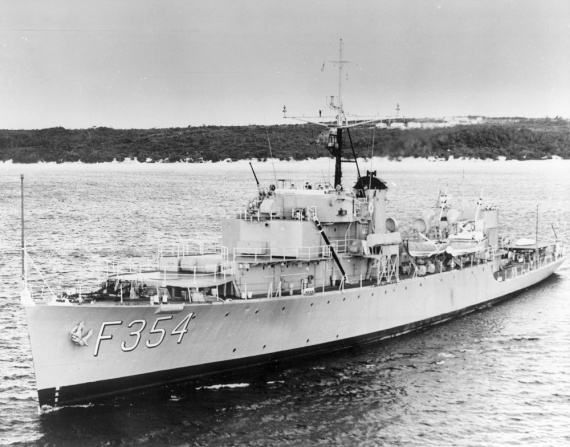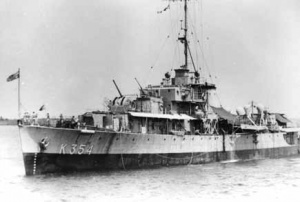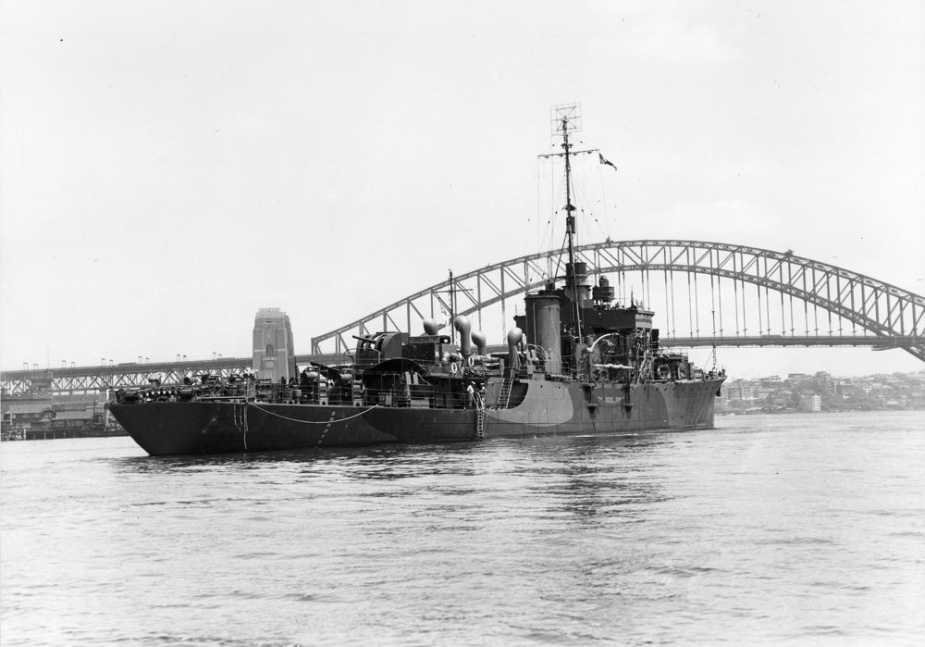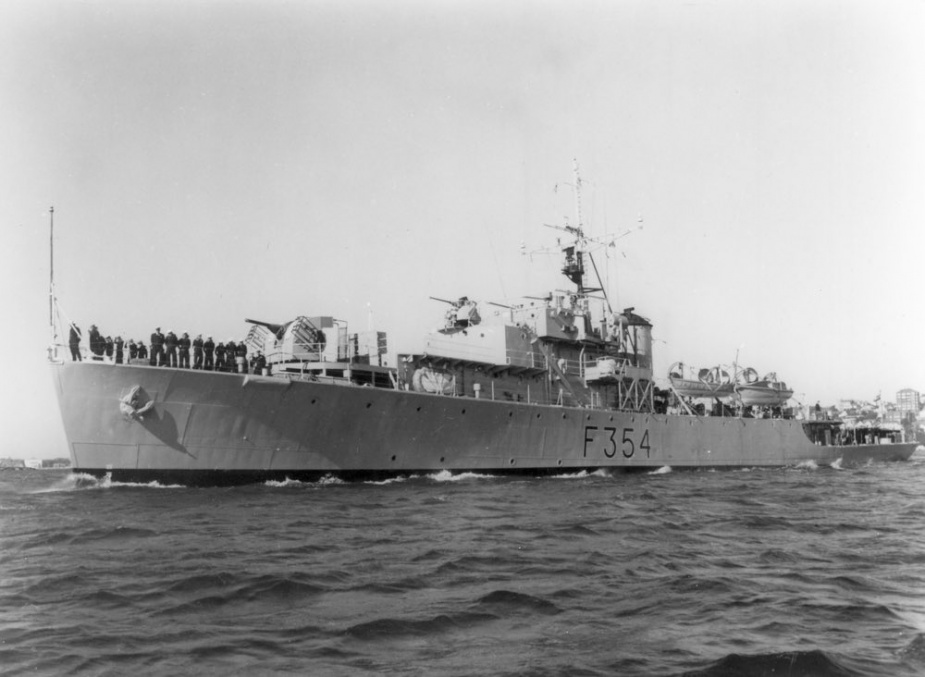
HMAS Gascoyne was ordered as part of Australia"s shipbuilding program during the Second World War. Twelve of these Australian built frigates were to enter service with the Royal Australian Navy. A further ten were ordered but cancelled as the war drew to a close.
Eight, HMA Ships Barcoo, Barwon, Burdekin, Diamantina, Gascoyne, Hawkesbury, Lachlan and Macquarie, were built to the British River Class design and Australia likewise named its frigates after Australian rivers. A further four, HMA Ships Condamine, Culgoa, Murchison and Shoalhaven, were also named after Australian rivers but were built to the design of the Royal Navy"s Bay Class Frigates. These latter ships were generally known as Modified River Class Frigates although they are sometimes referred to as Bay Class.
Gascoyne commissioned at Sydney on 18 November 1943 under the command of Lieutenant Commander Jack Donovan, RAN.
She completed her working up trials and exercises in the Sydney area at the close of January 1944. On 5 February 1944 she sailed for Milne Bay in New Guinea, where she operated as an escort vessel in local waters. From 26 to 29 February she was engaged in anti-submarine protection for the United States Transport President Grant which was stranded on Suckling Reef. In March, April and May she remained in New Guinea waters serving mainly as an escort vessel for convoys proceeding north from the American base at Manus Island. On 31 May 1944 she returned to Sydney for docking.
On 7 August 1944 Gascoyne returned to New Guinea where she resumed duty as an escort vessel based at Manus. In early October she relieved HMAS Warrego, at that time attached to the United States Hydrographic Unit of the United States Seventh Fleet. Later that month she sailed for the Leyte Gulf in the Philippines with the advance elements of the American forces assembled for the attack on the central Philippines.
Gascoyne operated as a Survey Vessel in the Philippines from 18 October, two days before the landings at Leyte Gulf, until 17 November when she proceeded for Manus. During October, 39 air attacks were experienced in close vicinity to the ship and 30 Japanese aircraft were shot down within sight of her complement. Four bombs fell within 100 yards of Gascoyne but she suffered no damage and her only casualty was one man wounded. In November she was again the target of several enemy aircraft but was not hit or damaged.
Gascoyne sailed from Manus to return to Leyte on 16 December 1944 and arrived in San Pedro Bay on 21 December and there resumed duty as a Survey Vessel. On Christmas Eve, when anchored at Guiuan, the Dutch vessel Sommelsdijck lying nearby was hit and set on fire by an aerial torpedo. The Australian frigate organised the removal of 1300 troops from the burning ship and assisted by USS Buttonwood subsequently successfully subdued and finally extinguished the flames.
On 2 January 1945 Gascoyne sailed from Leyte as part of the great armada assembled in San Pedro Bay for the second phase of the Philippines campaign which aimed at the prompt extension of the success gained at Leyte by a landing at Lingayen as a preliminary to the seizure of Central Luzon and reoccupation of Manila. En route she experienced her first surface action of the war when in company with HMAS Warrego and USS Bennion she engaged two Japanese destroyers at long range.
Operating as a unit of the United States Minesweeping and Hydrographic Task Group, Gascoyne served in the Lingayen Gulf area until 10 January when she proceeded to Leyte and thence to Manus where she arrived on 23 January. On 1 February she transferred to the control of Rear Admiral Kaufman USN, Commander Philippine Sea Frontier, for service as an escort vessel. On this duty she served as escort for convoys proceeding to the newly conquered areas in the Philippines. In mid April 1945 Gascoyne returned to Sydney and thence to Melbourne for refit.
In June 1945 Gascoyne returned to New Guinea waters where she was engaged on further escort duty. In July she took part in the seizure by Australian forces of the Balikpapan area in Borneo, including bombardment support for the troops ashore. August, the last month of the war, was spent escorting convoys to Borneo. In September she took part in the surrender of Japanese forces in Borneo, being used to transport the Commanding General of the Japanese 2nd Army.
The remaining period of 1945 was spent transporting troops and stores, a service which took the frigate into the Moluccas, Halmaheras, Borneo and Timor. She returned to Sydney on 5 January 1946 having steamed 81,584 miles on war service.
On 12 April 1946 Gascoyne paid off at Sydney into Reserve. She was briefly recommissioned for the period of 1 July 1947 to 15 August 1947, to facilitate her passage from Sydney to Melbourne, where she underwent a refit. On completion of the refit, she recommissioned on 12 January 1948 for the return passage to Sydney. Without again proceeding to sea, Gascoyne paid off again on 26 November 1948.
Following a period of over ten and a half years in Reserve, Gascoyne recommissioned at Sydney on 8 June 1959, under the command of Lieutenant Commander John Nicholas, RAN for survey and oceanographic research duty. She was converted and specially fitted and equipped for this task, including the provision of laboratories on board.
Following over six years service as a survey and oceanographic research ship, Gascoyne paid off on 1 February 1966. She had steamed more than 218,930 miles on oceanographic research service. Overall she steamed 301,781 miles.
Without being brought forward for further service, Gascoyne was sold as scrap on 15 February 1972 to the Fujita Salvage Company Limited of Osaka, Japan. On 6 July 1972 the Japanese tug Sumi Maru left Melbourne for Japan with Gascoyne and the former destroyer HMAS Quickmatch in tow.
Specifications
 |
| Class |
River Class |
|---|---|
| Type |
Frigate/Oceanographic Research Ship |
| Pennant |
K354 |
| Builder |
Mort"s Dock & Engineering Co Ltd, Sydney |
| Laid Down |
3 July 1942 |
| Launched |
20 February 1943 |
| Launched by |
Lady Wakehurst, wife of the Governor of New South Wales |
| Commissioned |
18 November 1943 |
| Decommissioned |
1 February 1966 |
| Dimensions & Displacement | |
| Displacement |
|
| Length | 301 feet 6 inches (overall) |
| Beam | 36 inches 7.75 inches |
| Draught | 12 feet (mean) |
| Performance | |
| Speed | 20 knots |
| Complement | |
| Crew | 140 |
| Propulsion | |
| Machinery | Triple expansion, 2 shafts |
| Horsepower | 5500 ihp |
| Armament | |
| Guns |
|
| Other Armament |
|
| Awards | |
| Battle Honours |
|

